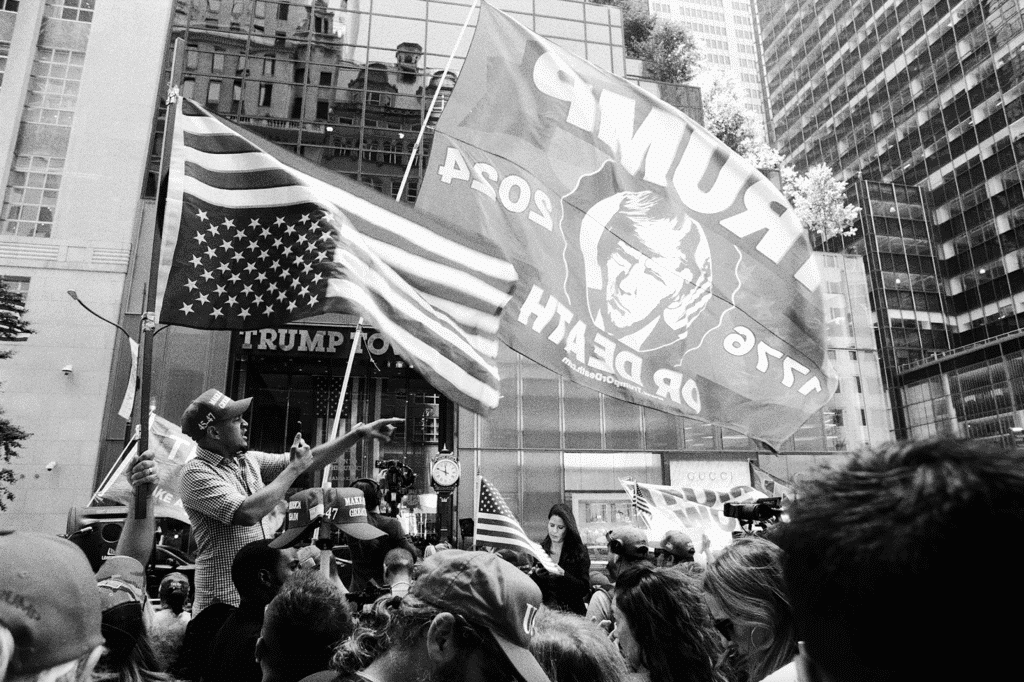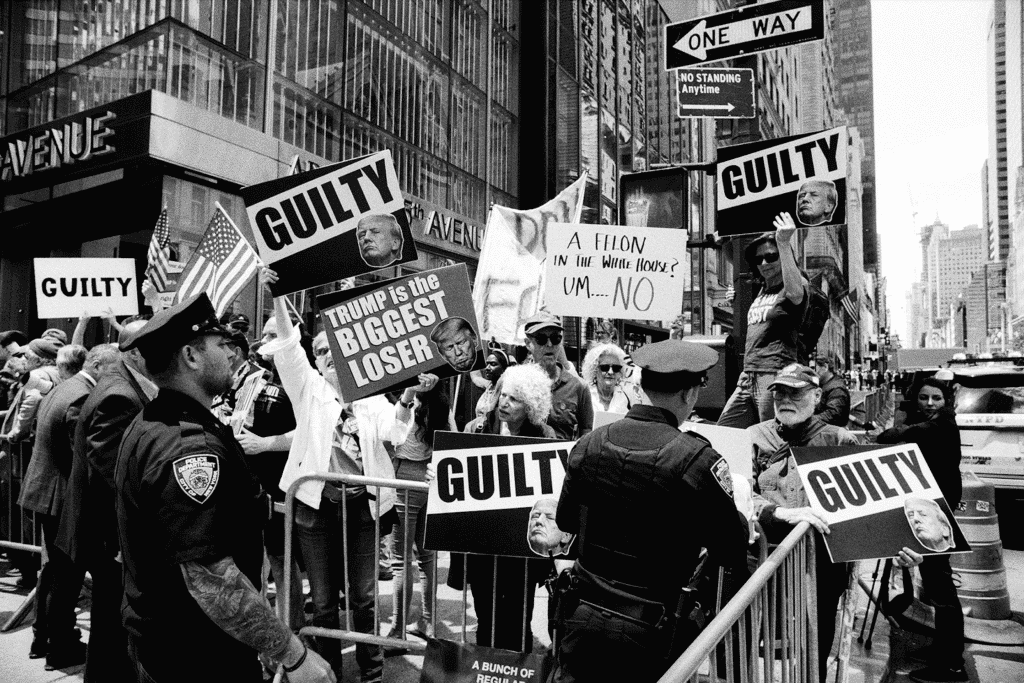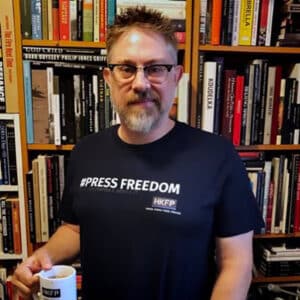On May 31, 2024 I was outside of the Trump Tower on 5th Avenue in Manhattan, cameras in hand, extra film in my pocket, and my city issued press pass around my neck. Former U.S. president Donald Trump was inside, giving a press conference in response to his conviction the day before on all 34 counts in his hush money trial stemming from his paying of porn star Stormy Daniels to keep the story out of the press.
Outside both Trump supporters and those rallying against him had gathered, separated by both 5th Avenue, and the police and the barricades they had set up for this express purpose. While my press pass allowed me access to both groups, and both sides of the street, the space in between was off limits, other than being able to take a photograph or two as I crossed. No lingering was allowed.
While the crowd at first appeared large as I approached the scene, it quickly became apparent that it was a relatively small number of protestors on both sides. Most of those there along 5th Avenue were other journalists who had come in great numbers to cover the event from just about every important American TV station, newspaper, and magazine. There was also a large number of tourists, who mainly seemed to have stopped to see what was going on and watch the spectacle in front of them.
In their midst there were maybe two dozen on the pro-Trump side, on the sidewalk opposite Trump Tower, with their usual collection of flags and signs, and playing music from a speaker someone had. One man seemed to be trying to give a speech, or was yelling at the opposing protestors, but his voice was lost in the din. Others were talking to passersby or journalists about their thoughts on the conviction, why they thought Trump would win the presidency again, and their political leanings in general.
The anti-Trump crowd was also along 5th Avenue, but South of the corner of the building on 5th Avenue. Likewise, these people were maybe, at most, two dozen of them. They had the usual signs, and a few chants, but were relatively calm and not as bombastic as their counterparts. Some of them were talking to the journalists present and discussing what was going on around them.

Today, a lot has changed. President Biden has withdrawn from the race, and Vice President Kamala Harris is now the top of the ticket, energizing the Democratic Party. There was a real assassination attempt on Trump, and a false one. The photo of him with fist raised and blood running down his cheek quickly circled the globe. Both parties have held their conventions. And the presidential race is still tight, with no one clearly in the lead, though polls are showing Harris in a much better position.
I am no stranger to photographing protests. I spent 7 years documenting the Black Lives Matter Movement around the 5 boroughs of New York City. But covering this election night, and the days following, I feel is going to be even more chaotic than those years.
No matter who wins, I don’t foresee this being easily accepted by either side. It will be a combination of disbelief and anger that drives people into the streets. And mistrust in the election itself, already being put into peoples’ minds, will only fuel it more. And if the results drag on for days, or the courts get involved, the tensions will only grow.
This time, there will be no pens keeping the protestors contained, or in certain neighborhoods. Rather they will be widespread. It is going to be rough for the photojournalists out there on the front lines trying to document what will happen on election night, and the days after, myself included.
Some protestors have also been known to turn on journalists in the field. And the police, who are there nominally to keep things in order, don’t always follow through, and have swept journalists up and arrested or detained them while arresting protestors en masse.
New York City was forced to pay $13 million dollars in 2023 to protestors arrested during the protests over the death of George Floyd. And it is not just the police in New York City who have come under scrutiny for their response to the protests. In total, from cities across the country, it has cost nearly $150 million paid to protestors, journalists, legal observers, and bystanders who were wrongfully arrested. A few weeks ago, the city of Des Moines, Iowa paid a journalist $100,000 who was arrested during a protest in 2020.
The arrests also continue. Three journalists were recently arrested at the Democratic Convention in Chicago while doing their jobs to photograph pro-Palestinian protests in the city during the convention when they were caught up with protestors. Others have been arrested covering student led campus protests this year as well.
But being arrested or detained are not the only issues faced by journalists in what is sure to be a chaotic time. The Press Freedom Tracker, a nonpartisan news website and database that provides information on the number of press freedom violations in the United States, has already recorded 56 cases of assaults against journalists in 2024.
In the moments following the assassination attempt on Trump in Butler, Pennsylvania, the crowd turned on the journalists present, followed by pundits and right-wing politicians. Sophia Cali, a reporter for Axios, recounts coming face to face with Trump supporters yelling “This is your fault! You’re next! Your time is coming!” Others reported seeing middle fingers being flashed at them, and that rally goers got “heated” with journalists in the press section.
The years of referring to journalists as the “enemy of the people” and sowing mistrust in the news media has had a significant effect on trust in journalists in general. The influx of fake news, and the echo chambers that many people stay in where they both only hear what they want to believe based on their own ideals, and refuse to believe anything that goes against those ideals, makes the work of journalists harder and more dangerous.

As Reporters Without Border reports “According to recent studies, the level of distrust in the American media is unprecedented. The disinformation affecting American society has created an atmosphere where citizens no longer know who to trust. Online harassment, particularly towards women and minorities, is also a serious issue for journalists and can impact their quality of life and safety.”
This mistrust just further fuels distrust in those covering this election. In early August, news organizations were accused of doctoring photographs showing the large crowd that came to see Vice President Harris at the Detroit Metropolitan Airport. The Pew Research Center, in a 2022 report, showed that U.S. adults under 30 now trust information from social media almost as much as they do from national news outlets.
To add to all of this, various states, like Georgia, North Carolina, Nebraska, Wisconsin, and Nevada have all passed, or are working to instigate, new elections laws that could drastically change how the elections are run in those states. In total, 9 states, many battleground states that could decide the election, have changed election laws for 2024. The confusion that this could cause, and the inherent mistrust in elections in the U.S. that led to the January 6 riot at the Capitol, will only add to the chaos as results come in. Misinformation about the results will surely spread on social media, along with the massive amounts that already circulate, and result in wild accusations and beliefs in what they hear, regardless of the truth.
All of this puts journalists at risk as we work to cover the election on November 5th and the days following. The combination of mistrust in the media, election denialism, heavy handed police tactics, and general disdain towards journalists will more than likely result in both the arrest of journalists doing their jobs and potentially violence against them.
I don’t know what the answer is to solve the issue of trust in the press. I do know that it is not a problem that is going to be solved in time for the election, and that in fact, the election has the potential to make the situation worse. But there are resources for those of us who will be covering the election this year. The Committee to Protect Journalists (CPJ) has a website of resources for journalists.
The other thing we can do is to just keep an eye on each other when we are working. Take note of who is around and pay attention to your surroundings. If you see someone being harassed or potentially detained or arrested, contact CPJ (at [email protected]) to report what you have witnessed. CPJ can also be contacted via WhatsApp with an automated chatbot at +1-206-590-6191.
I really hope that I am wrong with my thoughts, fears and predictions. But in the meantime, I just prepare for what could turn out to be some long days and nights. Ultimately, I prepare to defend journalism and honest, truthful, fact-checked reporting, as I’ve dedicated my life to informing my fellow citizens about the events that define our world.


